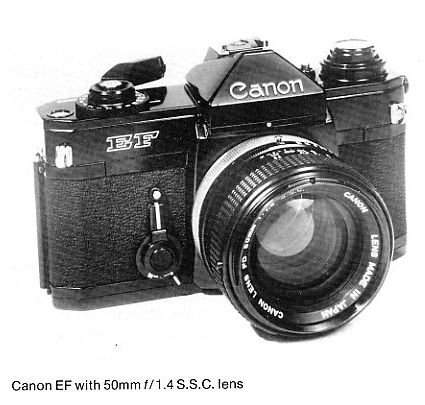

The Canon EF
The Canon EF is a fully automatic single-lens reflex camera that uses the shutter-speed priority method for setting the exposures. That means, you set the shutter speed and the camera sets the f/stop. The correct f/stop for the selected shutter speed is determined by the extremely sensitive silicon photocells, which measure the incoming light through the lens. With FL lenses the metering is done at the stopped down aperture, when FD lenses are used metering is done at full aperture. The metering system gives more emphasis to the central area of the viewfinder screen and much less to the upper part of the screen. This prevents underexposure of the main picture area if a bright sky is incorporated in the upper part of the picture. The silicon cells do not have a �memory,� as the CDS cells do, that means they respond instantaneously to changes of light intensity under normal lighting conditions. Under extremely dim lighting conditions, however, it takes about five seconds for the meter to adjust itself. Both the preselected shutter speed and the electronically selected f/stop are constantly visible in the viewfinder. Most of the modern automatic SLR cameras have these basic features, or at least similar ones, but the Canon EF has some additional features that cannot be found in other automatic SLRs.
Lets go step by step. When you depress the red button on the base plate of the camera near the two battery receptacle covers, a light-emitting diode illuminates if the batteries are o.k. The diode is located at the top plate of the camera left to the pentaprism housing. It also serves as an indicator of the camera�s working order during exposures of 1�30 sec. It blinks during the entire period of the long exposure.
The on-off switch not only turns the electronic circuits of the camera off, but also locks the shutter-release button to prevent the accidental release of the shutter. With cameras not having this feature, the shutter can go off when you close the camera case. When the on-off switch is moved to the ON position, the film advance lever pops out about 15 degrees and the camera is ready for operation. If you press the multiple-exposure button, located at the center of the on-off switch, you can cock the shutter without advancing the film. The film counter will not advance either during this operation.

The automatic exposure Memory-Lock button is one of the most useful features of the Canon EF. This button enables the photo�grapher to lock the metered f/stop at any moment. For instance, for backlit situations you can point the central area of the screen (where the highest sensitivity of the photocell is located) to the most important part of the picture area, or you may even go close to that most important part and take a close reading of it, and then press the Memory-Lock button. In this way you can obtain correct exposure when you move back to compose the picture. The Memory-Lock button is located near the film plane indicator mark to the left side of the pentaprism housing.
The self-timer lever is a multi-purpose lever. When it is pushed away from the lens, it serves as a self-timer and provides about a ten-second delay before the exposure is made. When you push the self-timer lever toward the lens, you get a depth-of-field preview. It is pushed toward the lens too, for stop-down metering. Below the self�timer lever is a small lever with the letters L and M. When the self�timer lever is pressed toward the lens for depth-of-field preview, it can be locked in this position by pushing the small lever to the L position. This same lever is set to the M position to lock the mirror in the up position.
Another ingenious feature of the Canon EF is the dual control of the shutter speeds. The fast shutter speeds (�/2�1/1000 sec.) are controlled mechanically. Only the slow speeds (1�30 sec.) are controlled electronically. This feature extends battery life, and it means that you can operate the camera even with dead batteries�something you cannot do with other electronically controlled shutter cameras.
Electronic-flash photography with the Canon Auto Tuning System (CAT) is as simple as focusing. The Speedlite 133D is slipped into the hot shoe, atop of the pentaprism, and the Flash-auto-ring is attached to the perimeter of the lens. The system automatically sets the proper exposure while you focus. The shutter-speed dial, of course, has to be set at the flash mark, which is 1/125 sec.
Breech-lock lens mounting permits fast lens changing, and all FD lenses mounted to the camera are instantly linked to the automatic exposure system. The maximum aperture of each lens used is set automatically. With some other camera systems, the maximum aperture of the lens has to be coupled to the camera meter manually. When changing lenses in the heat of work this step can be easily forgotten.
For automatic exposure control the aperture ring of the FD lens must be locked to the green 0 mark. When lenses other than FD are mounted to the Canon EF, metering can be done only through the stopped down aperture of the lens. The stopped down metering index mark is on the lower right side of the viewfinder.
Back - Previous page - Next page
� Christian Rollinger 2002